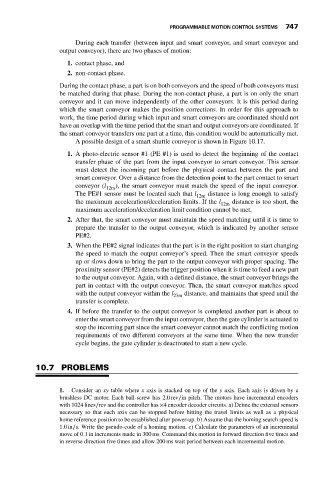Page 761 - Mechatronics with Experiments
P. 761
PROGRAMMABLE MOTION CONTROL SYSTEMS 747
During each transfer (between input and smart conveyor, and smart conveyor and
output conveyor), there are two phases of motion:
1. contact phase, and
2. non-contact phase.
During the contact phase, a part is on both conveyors and the speed of both conveyors must
be matched during that phase. During the non-contact phase, a part is on only the smart
conveyor and it can move independently of the other conveyors. It is this period during
which the smart conveyor makes the position corrections. In order for this approach to
work, the time period during which input and smart conveyors are coordinated should not
have an overlap with the time period that the smart and output conveyors are coordinated. If
the smart conveyor transfers one part at a time, this condition would be automatically met.
A possible design of a smart shuttle conveyor is shown in Figure 10.17.
1. A photo-electric sensor #1 (PE #1) is used to detect the beginning of the contact
transfer phase of the part from the input conveyor to smart conveyor. This sensor
must detect the incoming part before the physical contact between the part and
smart conveyor. Over a distance from the detection point to the part contact to smart
conveyor (l 12m ), the smart conveyor must match the speed of the input conveyor.
The PE#1 sensor must be located such that l 12m distance is long enough to satisfy
the maximum acceleration/deceleration limits. If the l 12m distance is too short, the
maximum acceleration/deceleration limit condition cannot be met.
2. After that, the smart conveyor must maintain the speed matching until it is time to
prepare the transfer to the output conveyor, which is indicated by another sensor
PE#2.
3. When the PE#2 signal indicates that the part is in the right position to start changing
the speed to match the output conveyor’s speed. Then the smart conveyor speeds
up or slows down to bring the part to the output conveyor with proper spacing. The
proximity sensor (PE#2) detects the trigger position when it is time to feed a new part
to the output conveyor. Again, with a defined distance, the smart conveyor brings the
part in contact with the output conveyor. Then, the smart conveyor matches speed
with the output conveyor within the l 23m distance, and maintains that speed until the
transfer is complete.
4. If before the transfer to the output conveyor is completed another part is about to
enter the smart conveyor from the input conveyor, then the gate cylinder is actuated to
stop the incoming part since the smart conveyor cannot match the conflicting motion
requirements of two different conveyors at the same time. When the new transfer
cycle begins, the gate cylinder is deactivated to start a new cycle.
10.7 PROBLEMS
1. Consider an xy table where x axis is stacked on top of the y axis. Each axis is driven by a
brushless DC motor. Each ball-screw has 2.0rev∕in pitch. The motors have incremental encoders
with 1024 lines∕rev and the controller has ×4 encoder decoder circuits. a) Define the external sensors
necessary so that each axis can be stopped before hitting the travel limits as well as a physical
home reference position to be established after power-up. b) Assume that the homing search speed is
1.0in∕s. Write the pseudo-code of a homing motion. c) Calculate the parameters of an incremental
move of 0.1 in increments made in 300 ms. Command this motion in forward direction five times and
in reverse direction five times and allow 200 ms wait period between each incremental motion.

